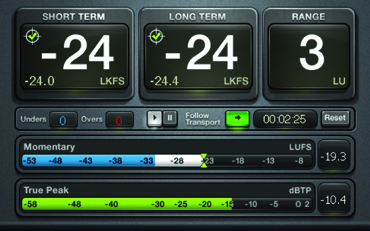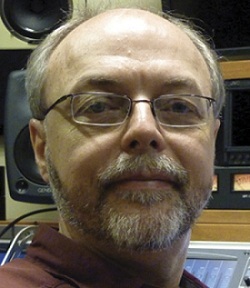
Meter display

It seems that most discussions about loudness management tend to focus on distribution as opposed to the content creation side of the chain. In fact, loudness management works best when content is properly managed from the beginning rather than somewhere downstream.
The document at the heart of the CALM Act, ATSC A/85, is very comprehensive and does its best to address loudness management at every step. There are many areas of the document that are of particular interest to television audio mixers. We’ll touch on a few of those areas here as we look at how loudness management plays out in the real world of television audio mixing.
One of things that surprised me when I first read through A/85 was how much space the document gives to setting up the control room environment. Rooms are divided into five categories, from high-end mix rooms in category one, to category five, where spaces are so difficult to work in that the engineer is advised to mix using headphones.
The document goes on to discuss proper loudspeaker location and calibration, controlling acoustics issues and even loudspeaker selection.
This eventually leads to another recommendation that might be a new concept to some, which is to calibrate the control-room monitor volume control and leave it alone. This recommendation most likely originated in the film-mixing world, where the control room has excellent acoustics, a very low noise floor and where the monitor volume is calibrated to –85 dB SPL, and then practically glued down.
Of course, most television mix rooms are the chaotic antithesis of this kind of environment, with intercoms blaring, equipment with fans nearby and constant shifts of focus from the engineer as he prepares for the next event coming his way.
The professional video industry's #1 source for news, trends and product and tech information. Sign up below.
The idea behind the A/85 control room recommendations is that the mix engineer should have a trusted, stable, calibrated mix environment that will allow him/her to rely on their ears rather than staring at a loudness meter for the duration of the program.
The distractions and noise ever-present in television audio mix rooms may cause control-room mix volumes to vary somewhat from A/85 recommendations, but the important idea here is that the audio engineer is able to mix with their ears rather than focusing on the meter.
LOUDNESS AND TRUE PEAK
Although some loudness meters display additional values on screen, there are two key measurements that the mixer must pay attention to: the Loudness value (LKFS), and the True Peak (TP) value. Loudness is the audio loudness of the mix, while true peak is the peak level of the mix. True Peak, like LKFS, is another new measurement and uses four times oversampling to catch peaks that older peak meters might miss.
All broadcasters have target loudness and maximum true peak values that they expect all content to meet, so the mixer will need to know what those values are and tailor the mix to them. If that information is unavailable, it’s a safe bet to mix to –24 LKFS and –2 dBTP, which are the recommended A/85 values for content without metadata.
Actually mixing with a loudness meter can seem a bit odd at first because most of them simply display a number on the screen that represents the loudness value of the mix. Some meters have other types of displays, but the loudness value is always a number.
There should also be a true peak reading somewhere on the display so it can be monitored as well. As for what should be measured, according to A/85, the anchor element should be isolated from the rest of the mix and measured. For most programming, the anchor element will be speech. If the anchor element can’t be isolated, then all mix channels, except for the LFE channel, should be sent together into the meter and measured.
Anyone mixing commercials or shortform content that is under three minutes is expected to measure the five primary surround channels, again minus the LFE, and not worry about the anchor element. It’s extremely important to mix to the actual target value rather than to either side of it. A/85 gives mixers 2 dB of breathing room on either side of the target, but go beyond it in either direction and the mix is suddenly out of compliance.
MEASURING LOUDNESS
I mentioned earlier that the preferred method of loudness management mixing is for the engineer to mix using their ears rather than staring at the meter, but there’s another reason not to watch the loudness display too closely. Loudness measurement is a measure that takes shape over time and the instantaneous readout on the meter won’t necessarily help with the long-term measure of the mix. Loudness meters typically measure in momentary (400ms), short-term (3s) and long-term-integrated measurements.
For live and long-form content production, the long-term integrated measurement should be used and the content should be measured from beginning to end if possible. There are certain places in the program where the loudness of the mix will be most scrutinized, so particular attention should be paid to these spots. The beginning of the program, in and out of commercial breaks and the end of the program are all places where the program will play against other content. If the loudness levels of the program and the adjacent content don’t match, it could generate complaints from listeners.
Despite having new measurements, meters and specifications to pay attention to, audio engineers are not really called to make significant changes to their workflow in order to properly manage loudness. They should mix as they always have while adapting to a fixed monitor volume, letting their ears guide them to proper loudness levels in their mixes and occasionally checking the loudness meter for reference.
The payoff for the audio engineer is that it significantly increases the likelihood that the mix they hear in the control room will be the same mix the viewer hears at home.
Jay Yeary is a broadcast audio engineer and television consultant based in Atlanta, Ga. His days are spent working alongside the engineering teams of a large media company.
